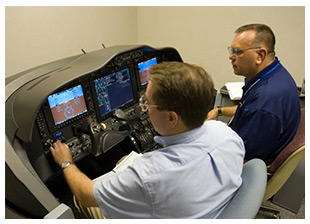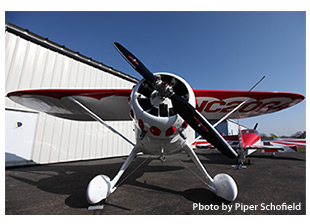Training Tips
|

A trainer is rolling down the runway for takeoff. The student pilot is holding right rudder to keep the airplane tracking straight ahead, and a little aileron into a gentle left crosswind, as the moment of rotation nears.
Suddenly, well before the airspeed arrives at that value, the aircraft's nose rises abruptly, and the student pilot finds the trainer airborne in mushy, semi-stalled flight. What's going on here?
Later, the experience will go down as an important learning experience. But for right now, a combination of instinct and stall-awareness training takes over, and the trainee lowers the pitch with one hand and quickly rough-trims the trainer with the other, to relieve the strong yoke-forward pressure that was required to get the nose down promptly.
That use of trim also provides the key clue to the nature of the problem: The aircraft was mis-trimmed for takeoff—in this case, trimmed excessively nose-up.
How did this scenario come about? More than likely distraction or sloppy use of the before-takeoff checklist kept the pilot from noticing the trim condition. But if the pilot who had flown the aircraft previously had used a large dose of nose-up trim for the final landing, the setting would likely have needed a significant adjustment for the next takeoff.
Why? The aircraft would have been trimmed to maintain an airspeed at or near its power-off stall speed. On the next takeoff run, when the aircraft passed through that airspeed while accelerating, the nose would have risen in an attempt to maintain an airspeed at or near Vso.
You may get a taste of the same kind of aircraft response, to a lesser extent, during touch-and-go practice. After you touch down, the usual drill is to retract the flaps, add takeoff power, and retrim while holding enough forward yoke pressure to keep the nose from rising prematurely.
Fortunately, a trainer with modest power and unhurried acceleration will pitch up less aggressively than a more "gutsy" aircraft would. But a surprise is a surprise—and critical phases of flight are no place for the unexpected.
After such an experience, there is little doubt that you will be more trim-conscious next time. But don't declare your analysis of the situation complete without determining how you came to overlook the pre-takeoff checklist item "Elevator trim—TAKEOFF" before pronouncing yourself ready to fly.
|
|
Flight Training News
|

Advocacy
The FAA has reduced the amount of simulator training a student can log, but AOPA is asking the agency to take a step back, allow more loggable sim time, and recognize the cost-effectiveness and efficiency of simulator time.
Read more...
Share:
 
Sporty's will transform solo video footage into a professional package.
Read more...
Share:
 
Article
Ryan McFarland, winner of the 2013 Lou Torres Flight Training Scholarship, has earned his private pilot certificate.
Read more...
Share:
 
The Association for Women in Aviation Maintenance has partnered with Bombardier Aerospace, DME Services of North Florida, Baker School of Aeronautics, and AWAM's Louisville chapter to offer three scholarships for those interested in the aircraft maintenance industry. Bombardier is offering a Learjet 45 maintenance course; Baker is awarding an FAA inspector authorization scholarship; and DME will award a $500 scholarship for the final oral and practical exam for the A&P license. AWAM's Louisville chapter gives a female senior or a recent graduate with a Bachelor's in Aviation or Aerospace Engineering an all-expense paid (including airfare) scholarship to the Women in Aviation Conference for 2014. The deadline to apply is Jan. 29.
Louisiana's Baton Rouge Community College was recently profiled in the Advocate for its helicopter pilot operations degree program. Students in the program can earn an associate of applied science degree while also becoming a certificated flight instructor. The college wants to help with demand for jobs in industries including oil and gas, emergency medicine, and law enforcement.
Central Washington University has issued a request for information to flight school contractors to train students for its aviation program. Contractors must be an FAA-approved flight school and provide certificated flight instructors who hold bachelor's degrees. Contractors also must ensure that the curriculum is approved by the university.
Flash-based, login required
Find out what to expect when frontal boundaries collide: Brush up before your next flight with the Air Safety Institute's Weather Wise: Air Masses and Fronts online course—and qualify for AOPA Accident Forgiveness and FAA Wings, to boot.
Take the course...
|
Training Resources
|
|
There's nothing difficult about operating at towered airports, but it is important to have a solid grasp of the procedures. Take this Air Safety Institute quiz to see if you’re prepared for your next flight out of a towered field.
Take the quiz...
|
|
Did you know that student pilots who join AOPA are three times more likely to complete their flight training? Membership includes unlimited access to aviation information by phone (800/USA-AOPA, weekdays from 8:30 a.m. to 8 p.m. Eastern time) or from Flight Training Online or AOPA Online. If you're not already a member, join today and get the pilot's edge.
|
AOPA Live
|
|
AOPA Live This Week
The NTSB's 2014 "Most Wanted" list of safety improvements calls for better distribution of hazardous weather information to pilots. Also, the AOPA Sweepstakes Debonair gets put through its paces, and Honeywell has technology that may one day directly link brain and aircraft.
AOPA Live This Week®, Jan. 16...
Share:
 
|
|
Career Pilot
|
|
Boeing set a company record in 2013 for the most commercial airplanes delivered in a single year, with 648, the company announced Jan. 6. Unfilled commercial orders stood at 5,080 at the end of the year, another company record. Three commercial airplane programs also set delivery records last year, with the deliveries of 440 Next-Generation 737s, 98 Boeing 777 aircraft, and 65 Dreamliners. Each of Boeing's commercial aircraft production sites—Everett and Renton, Wash., and North Charleston, S.C.—also posted record aircraft deliveries for the year.
A new name and logo for American Eagle, the regional carrier of American Airlines, are expected to be unveiled in the coming weeks, The Dallas Morning News reported Jan. 3. Pedro Fábregas, American Eagle's president, told employees that the change is to differentiate the company-owned regional carrier from other regional carriers that fly for American. Eagle executives first considered a name change in 2012, when its parent company began contracting with other regional carriers—Chautauqua Airlines, ExpressJet, Republic Airlines, and SkyWest operate regional flights for American; and US Airways uses several regional carriers—but the idea took a back seat to the recently completed merger of AMR Corp. and US Airways.
|
|
For more aviation career news, see the Flight Training website.
|
Plane Spotter
|

Walk down a row of T-hangars and behold gleaming examples of old and new aircraft, and occasionally, a showpiece that makes you feel as if you had wandered into an aviation museum. That's where you would most likely find an example of Don Luscombe-designed Monocoupes, early racers from aviation's golden age. With a 165-horsepower Warner radial engine, "clipped" wings, and conventional gear, Richard Smith's two-place 1937 Monocoupe 110SP would be at home in any display. But not yet! This Monocoupe is one of very few still flying, in Franklin, Pa.
|
Training Products
|
|
The January/February 2014 issue of FAA Safety Briefing explores the important role technology plays in keeping general aviation safe and efficient. Articles discuss the many benefits of emerging technologies as well as the potential safety hazards of being too technologically focused.
The fifth edition of the iconic book Weather Flying has been released. The book, written by the son of original author Robert N. Buck, is designed to make complex weather concepts understandable for even the least experienced of flyers. It also covers how computers, personal electronic devices, electronic flight instrument systems, and other technologies are changing the way general aviation pilots fly. The cost is $19.26 for hardcover and $11.99 on Kindle.
|
|
Note: Products listed have not been evaluated by ePilot editors unless otherwise noted. AOPA assumes no responsibility for products or services listed or for claims or actions by manufacturers or vendors.
|
Member Benefits
|
|
Members only
There is the tendency to associate "dozing off" with a presumption that the operator has sleep apnea. Falling asleep at the wheel is a problem, but the reason may not be related to sleep apnea.
Read more...
Share:
 
|
Blogs
|
|
A friend of blogger Chip Wright's was recently terminated while in training with a regional airline. In the regional sector, it's not unusual for an airline to terminate a new-hire without giving a specific reason. That was the case here, and the only explanation he received was that "there was something in [your] application."
Read more...
Share:
 
The flight characteristics of a helicopter make it suitable for a variety of interesting missions. One such job is the repair of live high voltage lines.
Read more...
Share:
 
|
Instrument Tip
|
|
IFR Fix
Even if there is no automation in your cockpit yet, your day may come. Stay ahead of the curve by including this subject matter in your proficiency regimen.
Read more...
Share:
 

What is a DME ARC or an LR? Get ready to fly the ILS or LOC approach into Runway 27 at Cheyenne, Wyo., and test your knowledge with this Air Safety Institute IFR Chart Quiz.
Take the quiz...
|
Final Exam
|
Question
If you must test your analog 121.5 MHz ELT outdoors, when should it be done?
Answer
The ELT should be tested only during the first 5 minutes after any hour. (Source: Aeronautical Information Manual, Section 6-2-4(b) Testing.)
|
|
Got a question for our technical services staff? Contact AOPA.
|
Career Opportunities
|
|
Looking for a way to use your skills to help the next generation of pilots? ATP is seeking a self-starting, experienced professional to fill the role of scheduling center associate to report to the director of admissions. Good communication skills are essential and inside sales experience is a plus. The successful candidate will ensure potential students receive the correct information they need.
Learn more now or search for other exciting career opportunities.
AOPA career opportunities
Ever dream of turning your passion for aviation into a career? We're looking for an account manager II, event planner, aviation technical writer contractor, coordinator of pilot community and development, director of insurance business operations, and Web graphic designer I. To learn more about other AOPA career opportunities,
visit AOPA Online.
|
 |
Education and Seminars
|
Flight Instructor Refresher Courses
Jan 25-26 - Baltimore, Md., and Long Beach, Calif.
Feb 8-9 - Fairfax, Va.; Nashua, N.H.; New Orleans, La.; and Louisville, Ky.
Feb 15-16 - Melbourne, Fla.; Oklahoma City, Okla.; Las Vegas, Nev.; and Fort Worth, Texas
Feb 22-23 - Sacramento, Calif.
For a complete schedule, see AOPA Online. Can't make it in person? Sign up for the Air Safety Institute's new Online eFIRC.
|
Air Safety Institute Safety Seminars
Jan 21 - Addison, Texas
Jan 22 -Fort Worth, Texas
Jan 27 - San Diego, Calif.; and Houston, Texas
Jan 28 - San Antonio, Texas; and Costa Mesa, Calif.
Topics vary—for details and a complete schedule, see AOPA Online.
|
|
Aviation Calendar
|
|
Want something to do this weekend? Planning an aviation getaway? See AOPA's enhanced calendar of events. Now you can filter events by date range, airport ID, state, or region. Before you take off on an adventure, make sure you check our current aviation weather provided by Jeppesen.
To include an event or to search all events in the calendar, visit AOPA Online. For airport details, including FBO fuel prices, see AOPA Airports.
AOPA Featured Events
Apr 26 — San Marcos, Texas. San Marcos Municipal Airport (KHYI). AOPA Fly-in.
May 31 — Indianapolis, Indiana. Indianapolis Regional Airport (KMQJ). AOPA Fly-in.
Jul 12 — Plymouth, Massachusetts. Plymouth Airport (KPYM). AOPA Fly-in.
Aug 16 — Spokane, Washington. Spokane Felts Field (KSFF). AOPA Fly-in.
Sep 20 — Chino, California. Chino Airport (KCNO). AOPA Fly-in.
Oct 4 — Frederick, Maryland. Frederick Municipal Airport (KFDK). AOPA Homecoming.
Nov 8 — Brunswick, Georgia. Malcom McKinnon Airport (KSSI). AOPA Fly-in.
|
|
|
|
 |
|
|
ePilot Flight Training Editor:
Benét Wilson
Production Team
Katie Richardson
Lezlie Ramsey
Melissa Whitehouse |
Contributors:
Sarah Deener
Alyssa Miller
Jim Moore
Jill W. Tallman
Warren Morningstar
Alton K. Marsh
Dave Hirschman
Tom Horne
Ian J. Twombly
Dan Namowitz |
|
|
|
|